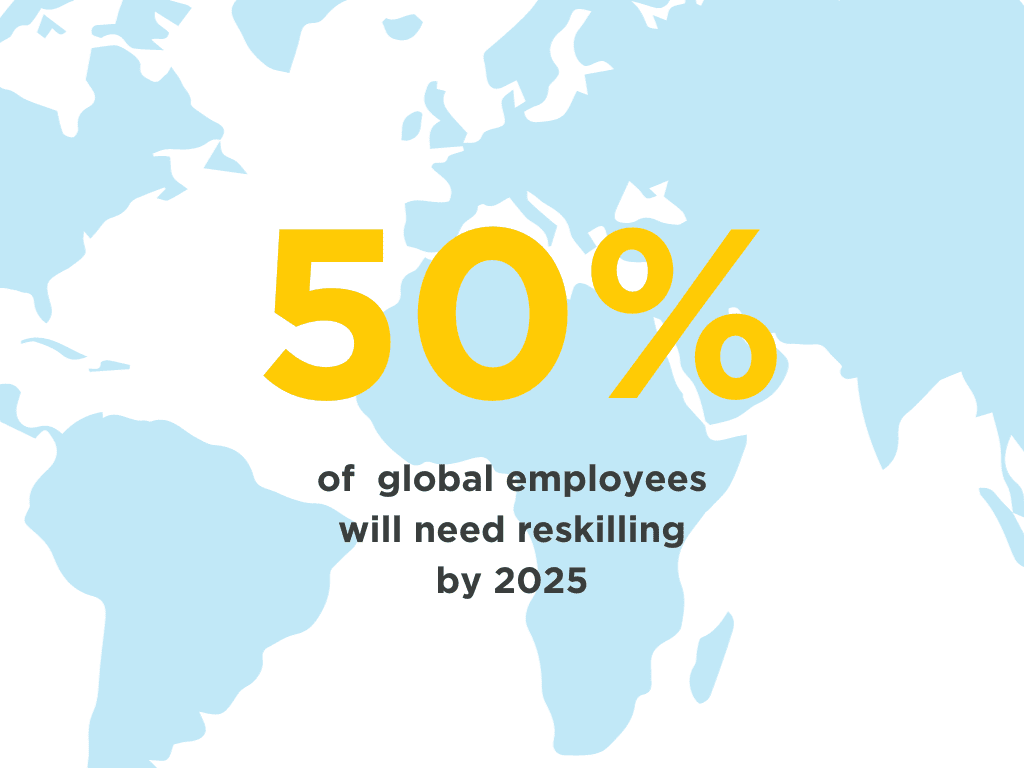The digital world is evolving unprecedentedly, and the demand for digital skills keeps increasing. Unfortunately, this area has a significant shortage of skilled workers, making it difficult for businesses to keep up with the ever-changing technological landscape.
A Salesforce report estimates that 14 countries could miss out on a $11.5 trillion cumulative GDP growth as a result of digital skills gap. That’s why businesses need to close the digital skills gap through upskilling, encouraging innovative learning and collaboration.
This article will delve into the current state of the digital skills gap and explore some strategies for bridging it.
Understanding the Current Digital Skills Gap
The digital skills gap presents a global challenge that impacts various sectors of the economy. Rapid technological advancements contribute to the widening gap, while limited access to digital training programs exacerbates the crisis. Bridging this gap is crucial for sustained economic growth, and upskilling programs are vital in equipping individuals with the digital skills required in today’s workforce.
Addressing the digital skills gap is essential for the global economy and the future of the labor market. Companies must proactively address and overcome this challenge to foster sustained growth and cultivate a skilled workforce, ensuring a skilled talent pool for sustained growth.

The Global Perspective on the Digital Skills Gap
The digital skills gap is a critical global issue affecting both developed and developing countries. According to the World Economic Forum, upskilling programs are vital in addressing this gap across various sectors, and 50% of global employees will need reskilling by 2025.
The need for digital skills hampers economies’ digital transformation and impacts their international competitiveness. Hiring managers need help finding workers with the necessary digital skills, posing a challenge for workforce training programs that require agile approaches. Bridging the digital skills gap is crucial for sustained growth and ensuring a skilled talent pool in the global workforce.
Factors Contributing to the Digital Skills Gap
The rapid digitalization of the global economy has created a demand for new technical skills, resulting in a skills gap crisis. Limited access to digital resources and training programs, particularly in rural areas and developing countries like South Africa, further exacerbates the digital skills gap. More investment in digital skill development programs also limits opportunities for individuals to acquire the necessary competencies.
The emphasis on technical skills in digital training programs often neglects the importance of soft skills, contributing to the widening gap. The digital skills gap is not confined to a specific industry; it affects various sectors, including financial services, data science, and artificial intelligence.
Exploring Challenges in Education and Technology
Several vital contributors influence the digital skills gap. One factor is the limitations within the educational system, where outdated curricula fail to keep up with evolving technological demands. The rapid pace of technological advancements outpaces the development of digital skills, widening the gap further. Automation and artificial intelligence also play a role in redefining skill requirements and presenting new challenges.
The lack of access to digital tools and resources inhibits skill development, exacerbating the skills gap crisis. Addressing this challenge requires proactive involvement from business leaders through workforce training programs.
Educational System Limitations
The rapid pace of digitalization has created a global economy where the educational system struggles to keep up. Outdated curricula need to equip students with the digital skills demanded in the labor market. Limited access to digital learning tools hampers skill development in educational institutions. Educational institutions must prioritize digital literacy to bridge the digital skills gap effectively. Collaboration between policymakers, educators, and business leaders is essential in addressing these limitations and ensuring a skilled talent pool for sustained growth in the evolving global workforce.
Rapid Technological Advancements
Rapid technological advancements, such as artificial intelligence (AI) and machine learning, have contributed significantly to the digital skills gap. The increasing automation of jobs has fueled the crisis, creating a pressing need for upskilling programs to bridge the gap effectively. Various sectors undergoing rapid digital transformation drive the demand for new digital skills, exacerbating the skills gap.
The need for digital skills hampers economic growth, making it imperative to address this challenge. Upskilling programs must adapt to evolving technologies and equip individuals with digital talent to overcome the digital skills crisis.
The Impact of Technology Advancement on Skill Requirements
The advancement of technology in the global economy has profoundly impacted skill requirements, contributing to the digital skills gap challenge. With automation and artificial intelligence redefining job roles, individuals need to acquire technical skills relevant to their industries.
As the digital economy continues to experience sustained growth, the demand for a skilled workforce becomes increasingly crucial. Upskilling programs must encompass both technical skills and soft skills. Bridging this new defining challenge of the digital skills crisis is vital for individuals and organizations.
The Growing Importance of Digital Literacy
Digital literacy plays a crucial role in bridging the global digital skills gap. To navigate the digital world and succeed in the global economy, individuals must possess basic digital skills, such as internet access, online learning, and proficiency with digital tools. These skills enable individuals to adapt to new technologies and contribute to their readiness for the workforce.
Policymakers, educators, and business leaders must prioritize digital literacy programs. This will help ensure that individuals have the necessary skills to access employment opportunities and contribute to sustained growth in the global workforce.
How Automation and AI are Redefining Skills
Automation and artificial intelligence (AI) are reshaping skill requirements, contributing to the ongoing challenge of the digital skills gap. Integrating automation and AI technologies necessitates upskilling programs to bridge this gap effectively. Technical skills such as data science and machine learning are in high demand due to the increasing prevalence of automation and AI.
The digital skills gap crisis emphasizes the importance of workers’ skills complementing automation and AI tools. Upskilling programs should focus on developing skills less susceptible to automation, enabling individuals to adapt and thrive in the changing business landscape.
Strategies for Bridging the Gap
Upskilling, online learning, and workforce training programs are vital in bridging the digital skills gap. Collaboration between business leaders, policymakers, and educational institutions is necessary to address this challenge. Accessible and affordable digital skill development programs can help bridge the gap, fostering economic growth. Individuals must be upskilled in technical and soft skills to bridge the digital skills gap effectively.
To address this issue, governments and organizations must invest in digital skill development programs. By implementing these strategies, we can bridge the digital skills gap and ensure a skilled workforce for the future.
Leveraging Technology as a Learning Tool
In the rapidly evolving global economy, the digital skills gap is expected to widen next year, posing a new defining challenge for individuals and businesses worldwide. Technology can be leveraged as a powerful learning tool. Online courses, digital certifications, and immersive learning experiences offer accessible avenues for upskilling. Employers should invest in training programs to equip their workforce with digital talent.
Likewise, individuals must actively seek free resources and online courses to stay updated with the latest advancements. Collaboration among educators, policymakers, and industry leaders is essential in addressing the digital skills crisis and preparing the global workforce for sustained growth.
Talentwize is an innovative solution that helps organizations recognize skills gaps in their workforce and the right skills that needed to be added to their team as well as track their employees’ progress.
The Role of Continuous Learning in the Workplace
Continuous learning is crucial in addressing the widening digital skills gap expected by 2023. As more jobs require technical expertise, employees must stay competitive in the labor market by upskilling and expanding their knowledge. Employers must invest in professional development and provide growth opportunities to retain skilled talent.
Online learning platforms, courses, and certifications offer a convenient way for employees to acquire the necessary digital skills. Creating a culture of learning not only attracts top talent but also enhances productivity. Continuous learning is the key to sustained growth and success in this global economy.
How Elev8 Has Helped Organizations Bridge the Gap
Elev8 has been instrumental in helping organizations bridge the widening digital skills gap. With technology advancing rapidly, the need for skilled talent has become a defining challenge for businesses globally. Elev8 understands this and offers customized training programs that cover a wide range of digital skills. From basic computer literacy to advanced coding and data analysis, these programs empower employees with the knowledge they need to thrive in the digital economy.
An example was how Elev8 transformed Nigeria’s leading bank’s tech challenges. We designed a solution that provided constant innovation and digital transformation through tech and power skills among the bank’s employees.
Similarly, we partnered with Microsoft and the Qatari Ministry of Communication and Technology (MCIT) to launch the Digital Center of Excellence in Qatar. The center has been a primary driver for digital transformation through reskilling and upskilling programs in Qatar.
Innovative Approaches to Upskilling Employees
In the face of the widening digital skills gap, innovative approaches to upskilling employees have become crucial. One such approach is microlearning, which allows employees to learn new skills through bite-sized modules in short, focused sessions. Gamification of training programs also plays a significant role by making learning fun and engaging, thereby increasing learner motivation and retention.
Immersive learning experiences provided through virtual reality and augmented reality training programs have proven highly effective. Collaborative learning, such as peer-to-peer and mentorship programs, further enhances skills development. Lastly, upskilling programs that offer digital badges or certifications validate skills and provide employee recognition.
How Can Your Organization Prepare for the Digital Future?
To prepare for the digital future:
- Assess your workforce’s digital skills gap and identify areas for improvement.
- Invest in training programs to upskill employees and close the gap.
- Foster a culture of continuous learning, collaborate with training providers and industry experts, and stay updated on digital trends to remain competitive.
At Elev8, we have helped numerous organizations bridge the digital skills gap through innovative approaches to upskilling employees. If you are looking to prepare your organization for the digital future, get in touch with us today.

![Featured image for article titled "[Case Study] Elev8 Transforms Nigeria's Leading Bank's Tech Talent Challenges" showing a person reading the article on a tablet with the elev8 logo behind.](https://www.elev8me.com/wp-content/uploads/2023/11/iStock-1297103501_blog-post-1024x384.jpg)


